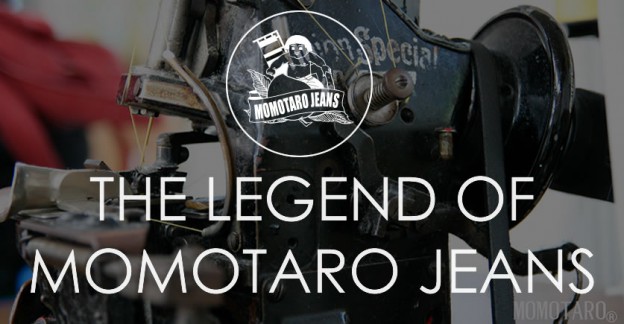With the great success of our Momotaro Jeans Giveaway contest (thank you all!), we want to follow up by going into the history of Momotaro Jeans.
Momotaro is the name of the hero of a very well known Japanese folklore “Momotaro Densetsu”. His name literally means “Peach Boy”. There are a few variations to how the folklore goes, however, based on the present form of the tale (dating back to the Edo period), Momotaro came to earth in a giant peach that floated down a river, to be found by an old lady who was childless and barren. The woman and her husband tried to eat the peach only to find that a child was inside it. Momotaro told the old couple that he was sent from Heaven to be their child. And so the couple named him Momotaro, from the words “momo” (peach) and “taro” (eldest son in a family).
Years later, Momotaro left home for a quest to defeat a band of marauding oni (demons). On his way there, he befriended a talking dog, monkey and pheasant that would help him in his quest. He went on to defeat the demons and went back home to his parents with plunders from the demons’ fort as well as the demon chief as captive. Momotaro and his family lived off well from the plunders he got from his quest.
This story has been told for generations and remains a part of Japanese culture today. The legend of Momotaro was one of hope, youth and rejuvenation. Momotaro descent to earth in a peach rejuvenated an old couple’s hope of having an offspring of their own. With such a legend as basis for the brand’s name, it’s only appropriate that Momotaro Jeans is determined to produce the highest quality denim that shouts of youth, rejuvenation and going after one’s dreams.
In the 1960’s, at the popularization of denim as more than just workwear, the youths in Japan demanded replicas of the American jeans they saw in Hollywood films. Hollywood celebrities like James Dean and Marlon Brando played a huge influence in bringing the American fashion to Japan. Most of the denim produced at the time was from the Kojima region of Okayama, Japan and although they were good replicas, the Japanese consumers wanted better.
It was only in the 1980’s that the Japan Blue Company was created and under it was Momotaro Denim. Momotaro began in 2005 under the company and has gained international fame for producing high, and sometimes over-the-top quality denim. Momotaro jeans are constructed from 100% Zibabwean cotton, which is renowned for their quality, durability and ability to hold indigo dye.
Momotaro Jeans now have a variety of labels under them, each having their own unique characteristics and catering to the different price and denim preferences their consumers might have. These labels include the Vintage label, the Copper label and the Battle label; to name a few. Each of this label has a specific characteristic that sets itself apart from the rest of the labels under Momotaro.
The Vintage label features a shrink-to-fit construction and a sturdier, rougher denim. The Copper label on the other hand a rope-dyed denim that is rinsed once in mineral water. The Battle label features the heaviest dark indigo denim and at the back pocket of the jeans, their signature white stripes. One look and you’d be able to recognize the Battle label stripes. Some other labels have unique characteristics like using a pink selvedge line and pink threads to mimic the pink of the peach in the Momotaro legend.
One particular label that might be of interest to those who want the highest quality denim they can get their hands on is definitely the Gold label. The denim on this label is woven from hand-operated shuttle looms that were used to make kimonos back in the day. It has been noted that 3 feet of this handwoven denim takes a professional about 8 hours to produce. A premium quality Momotaro jean of this label can cost up to $2000. This is the pinnacle of textile craftsmanship in the production of Japanese denim.
Momotaro Jeans have spent many years mastering the art of combining traditional Japanese techniques of producing and dying denim, with the modern details and fits inspired by western denim. Momotaro Jeans is simply one of the best that Japan has to offer. Just as how the legend of Momotaro has lived on till today, we can bet on seeing Momotaro Jeans being talked about for generations more to come.


Comments
2 responses to “The Legend of Momotaro”
I’ve had these for three months, with one soak, and there’s very liltte stretch or shrinkage. Cold soak gave me maybe .25, if that. I’ve read they’ll shrink only .5. I don’t like cuffing either, or too much stacking, and had them hemmed before wearing, one inch above my normal inseam. For me, they’re perfect, with at least .25 left for additional shrinkage, with the rest being used in the creases. I bought these true to size and the waist is still snug.
No shirt??? Me likey and also I’m totally love denim. I’m so in love in the idea of gteitng a pair of docs. But still not sure if they are my style. Also taking a break from blogs but I love to comment.